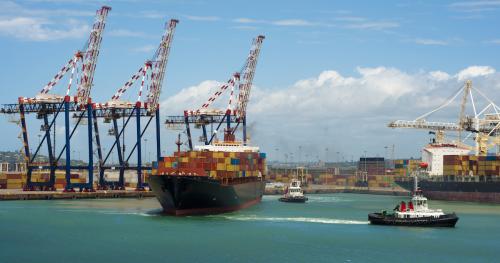In the years leading up to the August 2021 election of Zambian President Hakainde Hichilema, the government of the Republic of Zambia (GRZ) rolled out a series of fiscal policies that undermined the profitability of Zambian mining, a major obstacle for one of Africa’s leading copper and cobalt producers. This included the 10th royalty increase in 16 years, double taxation by which royalty payments were not tax deductible for corporate income tax, withheld value-tax refunds, and a 5% import levy that made domestic processing uncompetitive and increased uncertainty of tenure as the government sought to take mines over.
These policies yielded significant consequences for investors—companies withheld $650 million of investment in 2019. They also triggered divestment from firms such as Vedanta and Glencore. Firms found it difficult to operate without breakdowns and interruptions, due to little reinvestment in operations. Furthermore, these policy changes led to production cuts, a significant loss in export revenues given Zambia relies on copper for 75% of its export revenue, and a fiscal crisis as the country ultimately defaulted.
The election of Hichilema in 2021 marked the turnaround for Zambia’s mining sector. He set out the goal of expanding Zambian copper production from 800,000 tonnes per year to 3 million, over a decade. Under his leadership, the GRZ developed a policy environment that is conducive to attaining this goal: A review of the mining tax framework brought taxation to a stable and competitive level and ended double taxation. In a show of support not just to the mining sector but for increasing investment along the mining value chain, in April 2022, the GRZ also signed a memorandum of understanding (MOU) to leverage resources and build a regional value chain for electric vehicle (EV) batteries with the Democratic Republic of Congo (DRC).
Mining investment has followed. First Quantum Minerals announced a $1.3 billion investment to build a nickel mine and scale up copper production. Barrick Gold scaled up production, noting that the revised tax regime will free up cash flow to invest in extending the life of Lumwana mine from 2042 to 2060. These investments will upscale production and generate much-needed fiscal revenue.
While these initial signals are indeed positive, significant new investment will still be needed for Zambia to meet its ambitious copper targets. Here are three recommendations to enable Zambia to rapidly work toward its goal of producing 3 million tonnes of copper per year:
1. Leverage digital technology
At the U.S.-Africa Leaders Summit this past December in Washington, D.C., the U.S entered into an MOU in support of the prior agreement signed between Zambia and the DRC to promote a mine-to-assembly EV-battery value chain in the mineral-rich region. This MOU is a signal of intent from the U.S. to support this ambitious objective of moving up the critical-minerals value chain and encourages U.S. firms to provide technical expertise and financing.
At the concurrent Africa Business Forum in December 2022, a firm that uses artificial intelligence (AI) and machine learning to identify battery metal deposits, to reduce overall exploration costs and more rapidly identify deposits, announced a $150 million investment to build a copper mine in Zambia. They will use AI tools to process drilling data and optimize copper and cobalt exploration at the Mingomba Mine, which has the potential to be a top-tier copper mine. This approach can be replicated in additional mines in the region.
2. Manage risk
Risk perceptions change with policy changes. In a space of just two years, Zambia has gone from being perceived as “too risky” to invest in to an attractive mining jurisdiction. Maintaining these conducive policies is critical to both prevent divestment and attract new investment. The resulting stability will yield a substantial return in the long term. After the MOU was signed with the DRC, Bank of Zambia Governor Denny Kalyalya noted that the agreement would increase foreign exchange inflows in the long run. This would enable the country to more than just pay its debt servicing costs—but also finance critical development objectives.
It should be noted, however, that while the mining sector has experienced a rapid turnaround, the broader investment climate in Zambia remains sluggish as a result of the protracted resolution of Zambia’s debt default—another indication that while perceptions can shift quickly, poor fiscal policy decisionmaking can hamper the ability for a country to take advantage of an improved landscape. Zambia in 2023 is a case in point: While partner governments and investors applaud the improved political environment, in many cases actual investment remains curtailed pending a debt resolution.
3. Strengthen infrastructure
Infrastructure is a critical constraint to Zambia’s mining sector—and to the economy more broadly. In the 2019 World Economic Forum’s Global Competitiveness Index, Zambia’s infrastructure was ranked 124th out of 141 countries. Given Zambia’s debt challenges, the country should seek to leverage donor funding and concessional financing wherever possible. For example, Zambia can leverage the Partnership for Global Infrastructure and Investment (PGII), a G-7 initiative, which along with the private sector, aims to provide $600 billion over the next five years to support infrastructure development in low- and middle-income countries.
Ultimately, these three recommendations can help Zambia not only become one of the largest copper producers in the world, but also support the development of the EV battery value chain regionally. Other resource-rich African countries have much to learn from Zambia—it’s a good example that it’s never too late to leverage the mining sector for growth and fiscal sustainability.
The Brookings Institution is committed to quality, independence, and impact.
We are supported by a diverse array of funders. In line with our values and policies, each Brookings publication represents the sole views of its author(s).








Commentary
Tripling Zambia’s copper production: A way out of the debt crisis
July 12, 2023